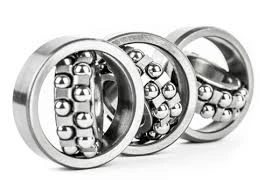
Dec . 04, 2024 14:15 Back to list
Understanding Thrust Bearings and Journal Bearings in Mechanical Engineering Applications
Understanding Thrust Bearings and Journal Bearings
In the world of mechanical engineering and machinery, bearings play a crucial role in facilitating the smooth operation of moving parts. Among the various types of bearings, thrust bearings and journal bearings are two of the most commonly used, each serving distinct functions and applications.
What is a Thrust Bearing?
A thrust bearing is designed to support axial loads, which are forces acting parallel to the axis of rotation. Unlike radial loads that act perpendicular to the shaft, axial loads can cause significant stress on the bearing system. Thrust bearings are typically employed in applications where the load direction is primarily along the rotational axis, such as in gearboxes, automotive applications, and various heavy machinery.
The construction of thrust bearings can vary, but they generally consist of flat or grooved surfaces that provide a low-friction interface between the rotating and stationary components. These bearings can be made from various materials, including steel, bronze, and even composite materials, depending on the specific requirements of the application. One common type of thrust bearing is the ball thrust bearing, which utilizes spherical balls to manage the axial load while reducing friction.
Applications of Thrust Bearings
Thrust bearings find their applications in several areas. For instance, in automotive applications, they are used in the clutches of manual transmissions to handle the thrust produced during gear engagement. Industrial machinery, such as milling machines and conveyor systems, also rely heavily on thrust bearings to maintain alignment and reduce wear from axial forces. Moreover, turbines and rotating equipment in oil refining and chemical processing industries often utilize thrust bearings to support significant loads.
what is thrust bearing and journal bearing

What is a Journal Bearing?
On the other hand, journal bearings are designed to support radial loads, which act perpendicular to the centerline of the shaft. They consist of a cylindrical surface that allows the shaft to rotate within it. The primary function of journal bearings is to reduce friction between the shaft and the bearing surface while supporting the weight of rotating components.
Journal bearings can be categorized into two main types plain bearings and tilting pad bearings. Plain bearings are simple and effective, with the shaft rotating directly against a cylindrical surface. Tilting pad bearings, however, use pads that can tilt slightly to accommodate changes in load and minimize friction, allowing for improved performance in high-speed applications.
Applications of Journal Bearings
Journal bearings are ubiquitous in various engineering applications. They are found in engines, turbines, compressors, and any machinery that involves shafts rotating at high speeds. In automotive engines, for example, journal bearings provide critical support to the crankshaft, allowing for efficient rotation while absorbing significant radial loads. In industrial machinery, such as pumps and electric motors, journal bearings ensure smooth operation and longevity, reducing maintenance costs and enhancing reliability.
Conclusion
In summary, both thrust bearings and journal bearings are vital components in modern machinery, serving unique purposes that enhance efficiency and reliability. Thrust bearings primarily manage axial loads, making them essential in applications where loads act along the axis of motion. Conversely, journal bearings are designed for radial load support, crucial for the rotating components in engines and industrial machines. Understanding the differences and applications of these bearings not only helps in selecting the right type for specific engineering needs but also contributes to the overall performance and durability of mechanical systems. As technology advances, the designs and materials used in these bearings continue to evolve, promising even greater efficiency and reliability in the future.
Latest news
-
Premium Deep Groove Ball Bearings | High Speed & Reliability
NewsAug.29,2025
-
Durable Scaffolding Clamps - Secure & Reliable Tube Connectors
NewsAug.28,2025
-
Common Failures in Thrust Ball Bearings and Solutions
NewsAug.22,2025
-
How Tapered Roller Bearings Can Take Shock Loads
NewsAug.22,2025
-
Angular Bearings in High-Precision Spindles
NewsAug.22,2025
-
The Impact of Misalignment on Cylindrical Roller Bearing Performance
NewsAug.22,2025
